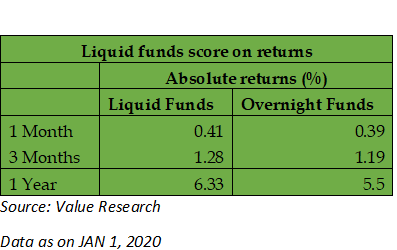



After the capital market regulator, Securities and Exchange Board of India imposed exit loads on liquid funds, many asset management companies and distributors have are pushing overnight funds as the preferred ‘short-term cash parking solution.’ Overnight funds, as a category of mutual fund schemes, came about in 2018 after SEBI formally introduced them as a separate category after its re-classification exercise. As the ‘liquidity’ of liquid funds has been affected marginally, investors are anxious about where to park their money temporarily?
The riskier of the two
To understand which of the two categories is riskier, let’s look at where these schemes invest. Overnight funds invest in securities that mature in one day, mainly referred to as the triparty repo trades for which the Clearing Corporation of India is the central counterparty. Overnight funds can also invest in other one-day instruments too, such as a one-day commercial paper. On the other hand, liquid funds can invest in securities maturing in up to 91 days. These would typically invest in certificates of deposits, commercial papers, treasury bills and other instruments that mature within a stipulated time period.
Because overnight funds get their money back in one day. They are the least risky schemes around. There is no interest rate risk. Liquid funds, too, are low-risk schemes. But some liquid funds were found having invested in securities of companies that had difficulty in repaying their creditors, including mutual funds. The net asset values of some liquid funds fell sharply as a result. This brought out the credit risk element in liquid funds.
Smooth withdrawal
Ease of withdrawal depends on the scheme’s exit load. Overnight funds do not have exit loads. Liquid funds too did not have exit loads till recently. However, from October 20, 2019, SEBI introduced graded exit loads. The load falls from 0.007 per cent on the first day to 0.0045 per cent on the sixth day from the date of investment. There is no exit load from the seventh day onwards. The idea behind the introduction of exit loads on investments in liquid funds is to shift the very short-term money to overnight funds.
Returns these schemes deliver
Returns are modest since both these categories are meant to park your surplus funds temporarily. These are not permanent investment options. The table gives an idea of the returns delivered.

Overnight funds charge 4 basis points to 81 basis points as expense ratio, whereas liquid funds levy 5 basis points to 97 basis points. As of November 2019, overnight funds had Rs 40000 crore assets under management, whereas liquid funds managed Rs 4.92 trillion.
Which category is better?
Liquid funds can be used to park your surplus for a short period, typically in excess of seven days. Overnight funds are meant for very short-term money. Size matters in debt funds and you’re better off investing in schemes that are as large (and therefore better diversified) as possible.
Individual investors looking for systematic transfer plans to equity funds in a staggered manner can still consider liquid funds. Ensure that you switch only seven days after making the investment. The idea is to avoid exit loads.
Discover the latest Business News, Sensex, and Nifty updates. Obtain Personal Finance insights, tax queries, and expert opinions on Moneycontrol or download the Moneycontrol App to stay updated!
Find the best of Al News in one place, specially curated for you every weekend.
Stay on top of the latest tech trends and biggest startup news.